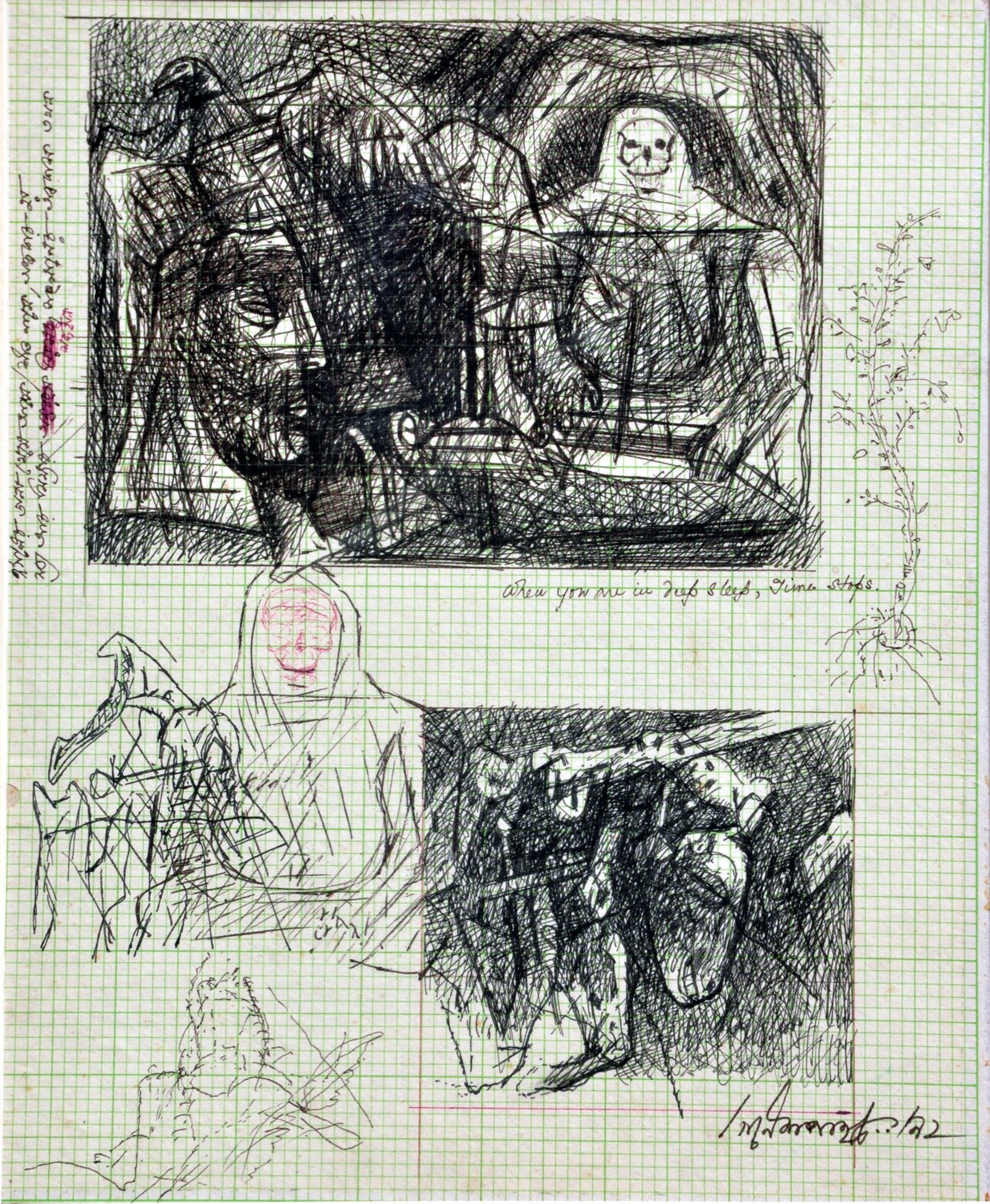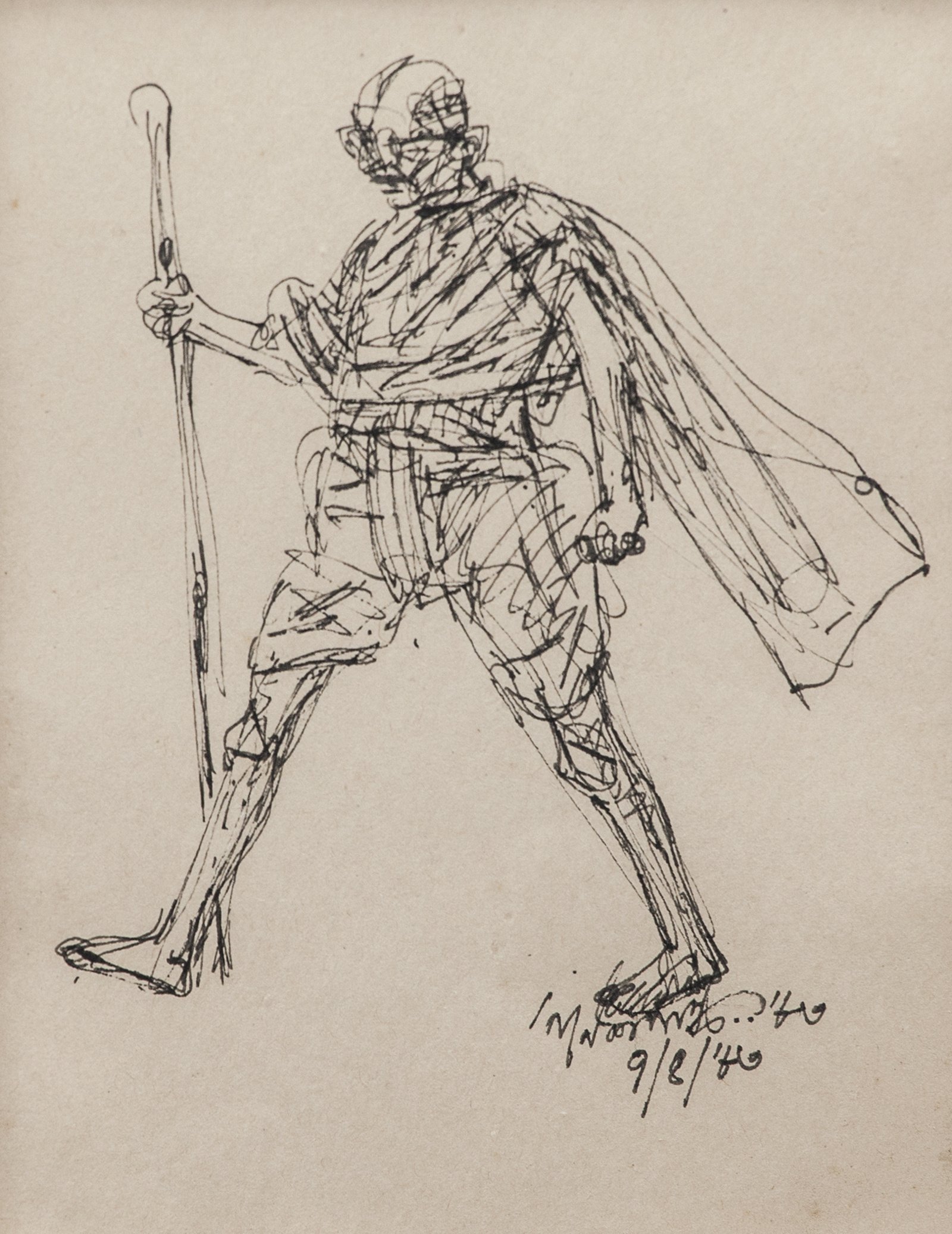
Ganesh Pyne
August 28 - October 6, 2014 at Akar Prakar, Delhi
Ganesh Pyne’s life-long engagement with the idea of lonesome being’s losing encounter with unknown terror of death is an inevitable staff of concern of mythologies across cultures. Yet, it is almost impossible to trace mythography (in the sense of graphic representation of a pre-existing mythological text) in any of Pyne’s work.
However, the visual narration he constructs, by ordering metaphorical images, strongly suggest, howsoever distantly it is, of associations of several mythologies, at the same time. It is because Pyne’s narratives are resultant of mythopoeic imagination.
It is of little consequence whether the iconic head or the death-mask is of Chandsaudagar the defiant worshipper or of Lakhindar, his hapless son pawned to divine wrath, from Chandimangal and Manasamangal, which for several of Pyne’s work have been warps for weaving his narrations. More important, however, is the narrative of the death defying valiant voyager’s predicament on a put-together raft; the broken oar of the sailor and scabbard of the warrior are tied together out of use. Ganesh Pyne has constructed, in this work, yet another age-old heroic myth of the tragic hero whose travails are no different from that of the straight individuals in our own trying times.
Pranabranjan Ray
Ganesh Pyne | Untitled | Tempera on Canvas | 1.5 x 21.25 in | 1990
Ganesh Pyne | Untitled | Wash & ink on paper | 5 x 6.75 in | 1977
Ganesh Pyne | Untitled | Mixed media | 13.75 x 10.25 in | 1999
Ganesh Pyne | Untitled | Jotting | 10 x 8 in | 1992
Ganesh Pyne | Banalata | Mixed media on paper | 9.5 x 7.5 in | 1998
Ganesh Pyne | Untitled | Jotting on diary paper | 9 x 6.75 in | 1997
Ganesh Pyne | Untitled | Jotting on diary paper | 9 x 6.75 in | 1997
Ganesh Pyne | Untitled | Tempera on paper | 12 x 16 in | 1972
Ganesh Pyne | Untitled | Pen & ink on paper | 7.25 x 9 in | 2008
Ganesh Pyne | Untitled | Pen & ink on paper | 6.5 x 9.75 in | 1982
Ganesh Pyne | Untitled | Pen & ink on paper | 5.25 x 7.25 in | 1982
Ganesh Pyne | Untitled | Pen & ink on paper | 4.25 x 3.5 in | 1983
Ganesh Pyne | Untitled | Pen & ink on paper | 6.75 x 7.75 in | 1976
Ganesh Pyne | Untitled | Mixed media on paper | 9.75 x 7 in | 1987
Ganesh Pyne
Ganesh Pyne, an Indian painter and draughtsman, was born in Calcutta in 1937. An introverted child, Pyne began sketching and doodling right from his childhood. Born and brought up in Calcutta, living in a crumbling family mansion in Kabiraj Row, north Calcutta, Pyne grew up listening to his grandmother’s folktales and reading fantasy stories from children’s books, which was to create the vocabulary of his future art. During his childhood years, he also flipped through Mouchak, a Bengali children’s magazine, to which his family subscribed to. In the magazine, he came across a printed drawing by Abanindranath Tagore, the founder of the Bengal school art movement, which had a deep impact on him. Thereafter he started reading avidly and drawing on the slate with chalk for hours. In 1946, he lost his father; and following the Calcutta riots, which preceded India’s partition, his family moved to a safe zone at the Calcutta Medical College. The trauma at the age of 9 had a lasting impact on his life and work.
After finishing school, he joined the Government College of Art & Craft in Calcutta. In 1959, he received his diploma in drawing and painting. Later, Pyne developed his own style of “poetic surrealism”, fantasy and dark imagery, around the themes of Bengali folklore and mythology. After graduating from art college, Pyne decided against taking up a full-time job and commenced his artistic career in the early 1960s as a book illustrator and a sketch artist for animation films at Mandar Mullick’s studio in Calcutta. In 1963, he became a member of the newly-formed Society of Contemporary Artists. His early work was deeply influenced by the Bengal school, especially Abanindranath Tagore, who was a major influence in watercolour. For the painter, the 1970s was an important period, when he moved to watercolours. The tumultuous period of anger and despair in Bengal found expression in his art. Pyne started as a watercolourist in the Bengal-school mode, and gradually shifted to gouache and tempera for his subsequent abstract and surrealist work in ochre, black and blue shades.
Ganesh Pyne is well known for his small-scale works in tempera on canvas, watercolour on paper and gouache. He also painted microcosmic images and motifs from the world of Bengali fables and fairy tales, including the Thakumar Jhuli and similar sources like the music and lyrics of Baul singers.













